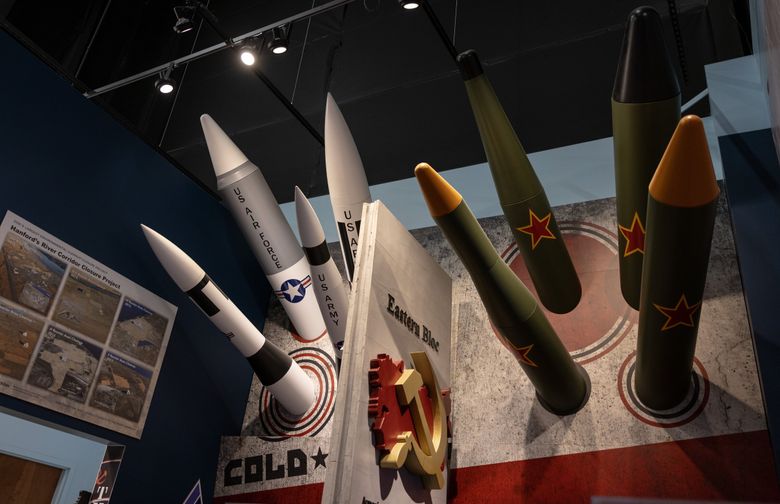
Kathy Criddle photographs birds from the Columbia River within the Hanford Reach National Monument on July 9. The national monument, established in 2000, is a haven for birders, anglers and others who enjoy the natural wonders around this free-flowing stretch of the Columbia. (Nick Wagner / The Seattle Times)
Aug. 3, 2025 at 6:00 am
By Gregory Scruggs
ABOARD THE CAN DO III ON THE COLUMBIA RIVER, Benton County — Todd Steele learned the river from his father, Rich. He got the boat, the Can Do III, from his dad, too. And back in 2000, Todd helped launch the Can Do II when Vice President Al Gore came to the Reach.
Gore’s visit on June 9, 2000, coincided with President Bill Clinton signing an executive order at the White House designating the Hanford Reach National Monument, preserving more than 196,000 acres and 46.5 miles of the Columbia from future dams, dredging and agriculture.
The presidential pen stroke protected the Chinook salmon gravel beds, the pelican roosts and the striking geology of the sagebrush steppe in one of the last relatively undisturbed pockets of the Columbia Basin. This parcel adjacent to the Hanford nuclear site in Central Washington is beloved by anglers and birders but also coveted by farmers.
Press accounts of Gore’s visit that day claim the vice president toured salmon spawning grounds on the Columbia near Richland. But Todd Steele insists Gore never even made it inside the boundaries of the national monument. Rich Steele ferried Gore, Sen. Patty Murray and Gov. Gary Locke around the Reach, but Secret Service agents nixed a proper river trip, Steele said. A photo op would have to suffice.
Todd chuckled at the memory of his father on a searing July afternoon as the cobalt Can Do III drifted downriver in the shadow of the imposing White Bluffs, thin layers of sediment piled 600 feet high over millions of years. Pelicans soared overhead and deer lapped water from the riverbank.
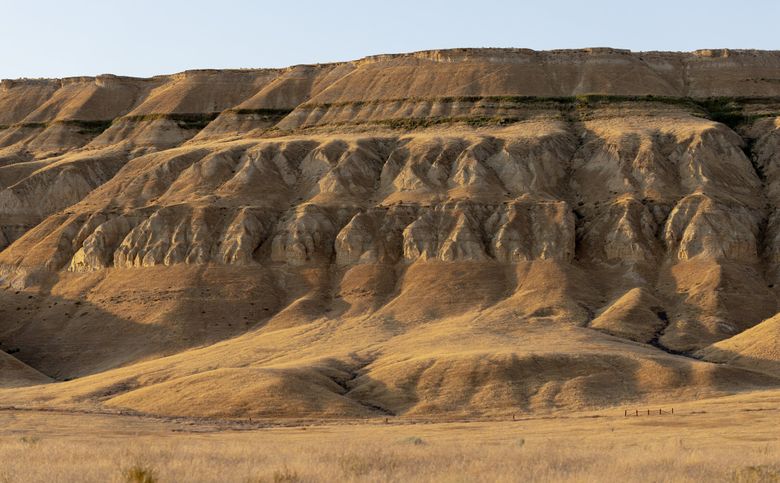 The evening light hits a portion of the Ringold Formation, part of Hanford Reach National Monument’s White Bluffs. The national monument was established in 2000, protecting one of Washington’s most unique natural areas. (Nick Wagner / The Seattle Times)
The evening light hits a portion of the Ringold Formation, part of Hanford Reach National Monument’s White Bluffs. The national monument was established in 2000, protecting one of Washington’s most unique natural areas. (Nick Wagner / The Seattle Times)
The broiling heat, the boat, the scenery, the flora and fauna — a quarter-century later, the scene felt similar, with one noticeable absence: Rich.
Until his death in July of last year at age 89, Rich Steele was an indefatigable defender of the Reach and these waters, the last nontidal, free-flowing stretch of the mighty Columbia south of the U.S.-Canada border. He was a giant from the generation of conservationists who saved the Reach.
Across a half-century of advocacy, Rich led hundreds of river jaunts at his own cost for visiting politicians, hosting representatives from county governments in the Tri-Cities, the governor’s mansion in Olympia and even the White House. The blue-collar environmentalist earned the respected nickname of “the Riverkeeper” for his efforts to persuade powerful people across partisan divides to protect the Reach.
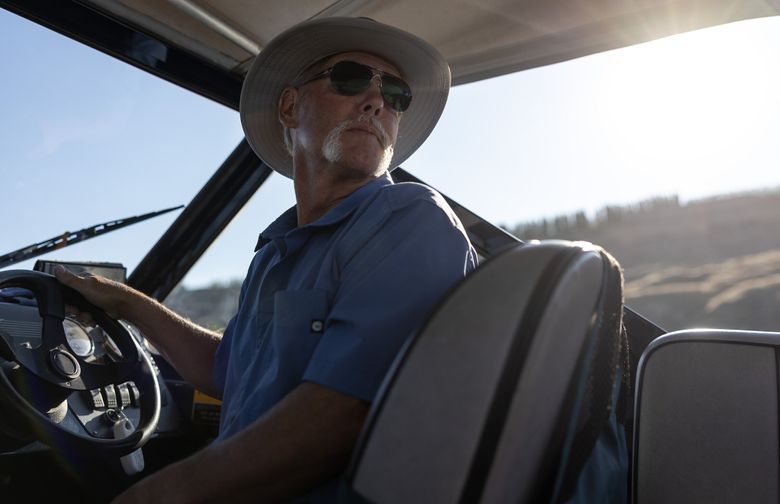
Todd Steele navigates the Columbia River within the Hanford Reach National Monument on July 9. Guarding this free-flowing stretch of the Columbia is a family business for the Steeles.
Todd, the youngest of three, tagged along often, lending a hand and quietly absorbing his plain-spoken father’s passion for this free-flowing stretch of the Columbia, whose cold, clear current has cleaved a braided channel of islands. It’s a stretch that feels like a river — a marked contrast to the reservoirs that stretch along most of the Columbia, tamed by hydroelectric dams.
“I was just there to support him,” Todd said.
Todd, 63, is now driving the boat — at a time when once-permanent protections for public lands seem less ironclad. The first Trump administration sought to shrink national monuments, and the current Congress has floated proposals to sell public land.
Later this month, Sen. Murray is booked to travel through the Reach by jetboat, stopping at Murray’s Beach, a sandy perch just upriver from the White Bluffs. It’s named for the senator, a longtime advocate for the Reach on Capitol Hill. She’s made this journey several times before, observing ongoing impacts on the river’s ecology from irrigation and agriculture.

The sprawling nuclear campus, which relied on cheap hydroelectric power and abundant river water for coolant, created a conservation paradox: Security concerns kept development off the Columbia as the Department of Energy established a buffer zone around its top-secret Cold War facility — and wildlife flourished in the vicinity of what some consider the world’s most contaminated environmental site.
When science company Battelle opened the Pacific Northwest National Laboratory in 1965, Rich worked on a boat as a lab technician, collecting water samples from Hanford Reach to test for radioactivity and monitor fish stocks. Motoring up and down the river, he learned every twist and turn.
“He was a self-made guy who surrounded himself with smart people,” Todd said.
An avid fly fisherman, Rich was roused to action when the Army Corps of Engineers proposed building the Ben Franklin Dam on the Columbia in the 1960s. While the dam would have generated enough power to cover 40% of Seattle’s annual electricity usage, it would have flooded Hanford Reach.
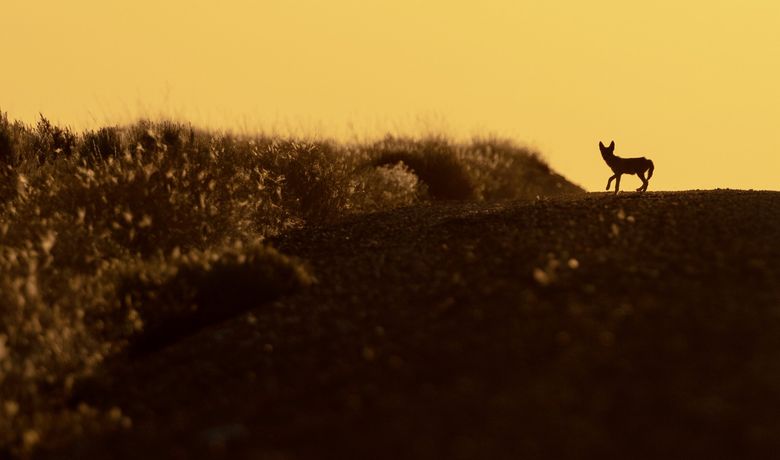
A coyote pup walks across a road in the Hanford Reach National Monument on July 8. (Nick Wagner / The Seattle Times)
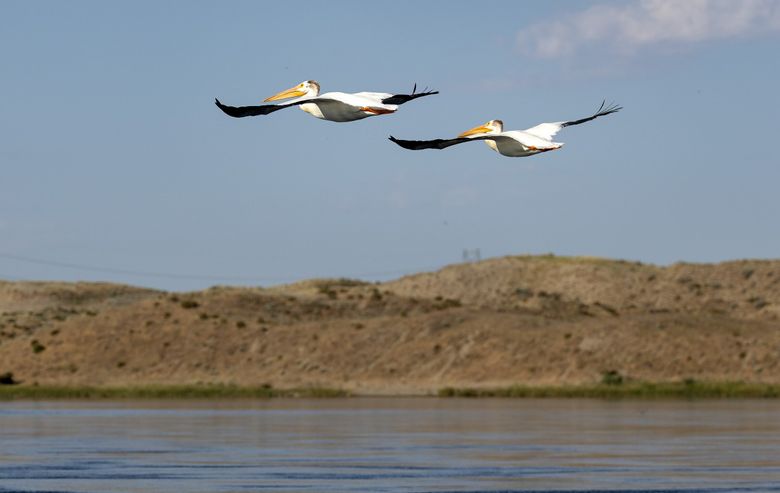
American white pelicans soar above the Columbia River on July 9. (Nick Wagner / The Seattle Times)
Rich had already lived through the erection of the Snake River Dams and John Day Dam, the combination of which eliminated coveted spots where he had fly-fished for steelhead on the banks of the Columbia and Snake.
“You could already see what damming a river does,” said Todd, tanned from a life under the desert sun, with a fuzzy red fly tied to his wide-brim hat. “We know what it takes away and the ecosystems it destroys.”
Rich founded the Columbia River Conservation League in 1968 with his neighbor Jack de Yonge — an editor at the Tri-City Herald and later editorial writer at the Seattle Post-Intelligencer — and Richland Rod and Gun Club President Lowell Johnson. They fought the dam, which the Corps shelved in 1970 and officially took off the table in 1981, then a Corps dredging proposal in the 1980s to make Wenatchee an inland port. Those threats prompted the Save the Reach campaign of the 1990s, calling for permanent protection from dams and dredging. The Washington Environmental Council bestowed its Citizen Environmental Hero Award on Rich Steele in 1995.
Murray attempted to shepherd a Wild and Scenic River designation for the Reach through Congress, but ultimately pivoted and lobbied Clinton to declare a national monument, which would not require a bill. She entered tributes to Rich into the Congressional Record three times, most recently on Sept. 9, 2024, to acknowledge his death. In her first entry, from 1996, she referred to him as “not your average environmentalist” who was “brought up the hard way in the Tri-Cities.”
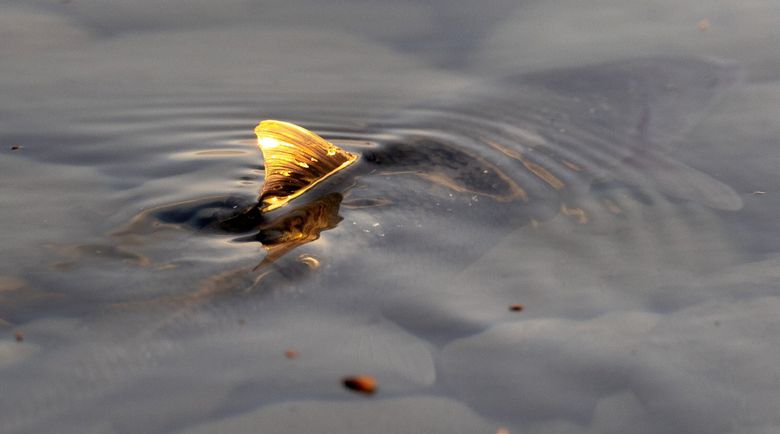
A fish’s dorsal fin reflects the sun as it swims in the Columbia River within the Hanford Reach National Monument on July 8. (Nick Wagner / The Seattle Times)
The Riverkeeper’s son
Rich’s persistently positive demeanor served him well as he sought support for conserving the Reach. Championing an environmental cause in politically conservative Central Washington required keeping up, as the boat name suggests, a can-do attitude.
The area’s Republican House representative, Doc Hastings, opposed the national monument’s establishment as federal overreach, arguing for local control of public lands. Reached by phone at his home in Pasco, the retired congressman hasn’t changed his tune in 25 years. The Washington Farm Bureau picketed Gore’s visit on the premise that the monument would remove future prime agricultural land from cultivation.
Todd is hospitable but not exuberant; he shines as a caregiver. Like his father, he began working odd jobs out of high school before landing at Hanford in the waning years of plutonium production — and then as part of the gargantuan cleanup effort.
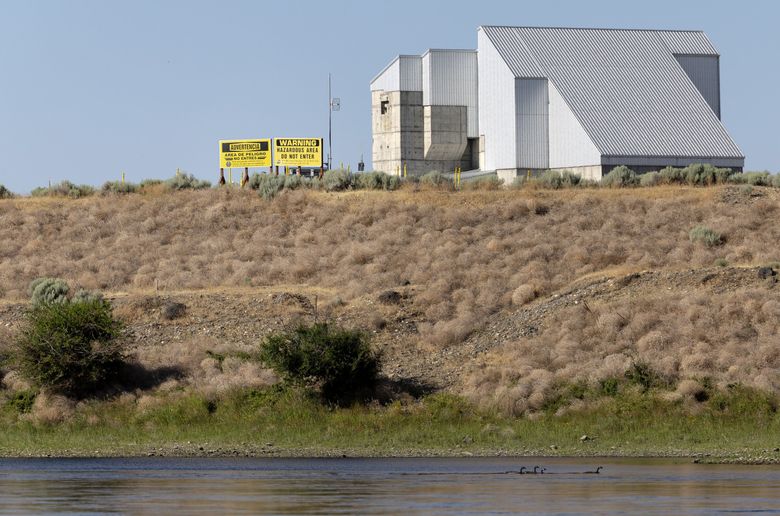
Warning signs mark a hazardous area of the Hanford Site nuclear production facility on July 9. (Nick Wagner / The Seattle Times)
Now retired, today he helps care for his autistic 5-year-old grandson, and in the last seven years of Rich’s life, Todd took care of the Riverkeeper, too. Not that the lifelong fisherman was content in a rocking chair. Todd, who keeps mules and horses on his Richland property, saddled up the animals to take his father on pack trips to alpine lakes. They hunted elk, deer and turkey together, too.
“We did all of those things that the Pacific Northwest has to offer,” he said.
Even late in life, Rich kept tabs on the river’s changing fortunes. When the first Trump administration initiated a review of national monuments with an eye toward shrinking or rescinding some of them, Rich intimated that he may come out of retirement to defend the area. Ultimately, Hanford Reach was dropped from the review.
Todd professes intimidated admiration for his father’s recall of political relationships and his ability to maintain a Rolodex of gubernatorial and senatorial aides. “He remembered all of the congressmen and local politicians that he had run-ins with, how he dealt with them and what their true ideals were,” Todd said.
An intuition for working the levers of power is not Todd’s forte, but he’s building confidence. A July river tour for The Seattle Times was Todd’s first time guiding an out-of-towner, a dress rehearsal for when he’ll have Murray’s undivided attention aboard the Can Do III later this month. Todd wants to show the senator the proliferation of invasive milfoil and star-grass that are choking prime salmon spawning grounds and to press her for more permanent protection of Hanford Reach, like elevating its status to a national park.
Fortunately, the Riverkeeper’s son doesn’t have to go it alone.
Karyn and Michael Wiemers, both in their 70s, were part of the Save the Reach campaign in the 1990s and remain active to this day as members of the Hanford Reach Citizens Committee. They’ll be on their own jetboat traveling upriver alongside Todd and Murray.
“He is so like his dad,” Karyn said. “The potential is there. He just needs a little bit of encouragement and support.”
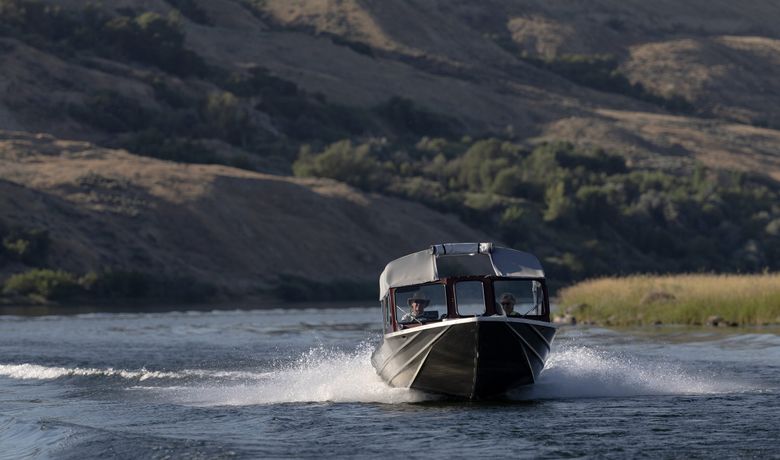
Mike and Karyn Wiemers boat on the Columbia River within the Hanford Reach National Monument on July 9. (Nick Wagner / The Seattle Times)
The Wiemers are providing those nudges from experience as confidants of the elder Steele. At points, Rich worked for Michael, one of the many Ph.D.s at Hanford. He preferred having Rich as a colleague on projects because of his strong work ethic.
“Todd doesn’t raise his voice, but he delivers a message effectively,” Michael said. “He’s an unassuming leader.”
The support network is also multigenerational, as the Steeles seek to uphold Rich’s family legacy.
“We were bystanders, but all the work that he did now can’t be for naught just because he’s not here anymore,” said Todd’s wife, Jackie.
Their daughter, Savanna, who works at Sound Transit and formerly for Rep. Suzan DelBene, will be on the jetboat tour as well. “She’s really good about bringing things out in Todd that he doesn’t think he can do,” Jackie said.
The next 25 years
As you float Hanford Reach, the river almost seems pristine near the Columbia’s northern and eastern banks.
Fish are few and far between in midsummer, but the gravel shores still nurse a fall run of “upriver brights” that accounts for 70% of all Chinook salmon in the entire Columbia River system. Sagebrush carpets Saddle Mountain to the north while the White Bluffs to the east showcase the scars of Central Washington’s remarkable geology, forged when the glacially powered Missoula floods raged at the end of the last ice age. The landscape brings to life the exhibitions on display at Richland’s REACH Museum, a natural history and science museum serving the Tri-Cities and one of the most tangible legacies of the establishment of the monument.
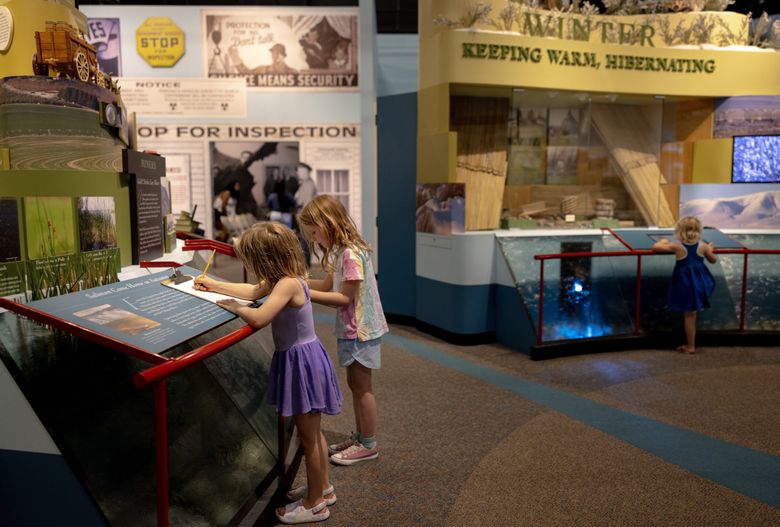
Children take notes while participating in a scavenger hunt at the REACH Museum on July 8 in Richland. (Nick Wagner / The Seattle Times)
Looking south and west yields a different vantage.
Nuclear reactors cocooned in steel, like oversized Monopoly pieces or a forgotten work by contemporary artists Christo and Jeanne-Claude, are monolithic reminders of the seemingly endless Hanford cleanup, currently slated to last into the 2070s. The national monument wraps around the Hanford site like Todd’s horseshoe mustache, and one day, in theory, the Department of Energy will declare the site decontaminated.
(The Department of Energy declined an interview request on postcleanup plans for the site.)
For today’s riverkeepers, however, agricultural runoff is a more worrisome toxin than nuclear contamination. Irrigation channels threaten the stability of bluffs on the river’s edge more than heavy machinery operating inland at the Hanford site. Lush green fields of grapes, apples and cherries hug the river outside the monument boundary. Todd fears that agricultural interests would encroach farther along the river if given the chance, like if the recently aborted congressional effort to sell public lands came back on the table.
“They wouldn’t care about these White Bluffs,” he said. “It’s not in their makeup. Their makeup is making money.”
Grower and agricultural researcher Alan Schreiber, who bought his farmland 3 miles from the monument in 1999, notes that the area was farmed before the federal government evicted residents for the Manhattan Project. “It’s some of the best farm ground in the Pacific Northwest,” he said. “That land returns very little to the economy and it could have been an agricultural powerhouse. But it’s also a fantastic place for wildlife and it wouldn’t be if it had been farmed.”
While he believes that local agricultural interests have made peace with the monument they once fought, he said the farming community has not forgotten federal promises to return the land and would eagerly turn it into farmland if given the opportunity and irrigation rights.
In the meantime, Hanford Reach National Monument remains under the management of the Fish and Wildlife Service, a federal agency that is more conservation- than recreation-oriented.
The agency’s official stance is that there are no maintained trails in the monument (although several are noted by Washington Trails Association). But public access to the area is limited to a few road-accessible overlooks and a couple of boat launches. There’s no campground partway, something that would make float trips more feasible. Despite legislative efforts by Hastings before he retired, potential hiking destinations like Rattlesnake Mountain remain off-limits to the public because local tribes — the area’s traditional inhabitants are the Nez Perce, Umatilla, Wanapum and Yakama — consider the site sacred.
“Once you build public trails and access starts to happen, that’s another hurdle in our way to be able to reclaim our tradition and culture as Wanapum people,” said Wanapum leader Clayton Buck, whose great-grandfather was promised by the federal government that the tribe, displaced by the Hanford site, could one day return.
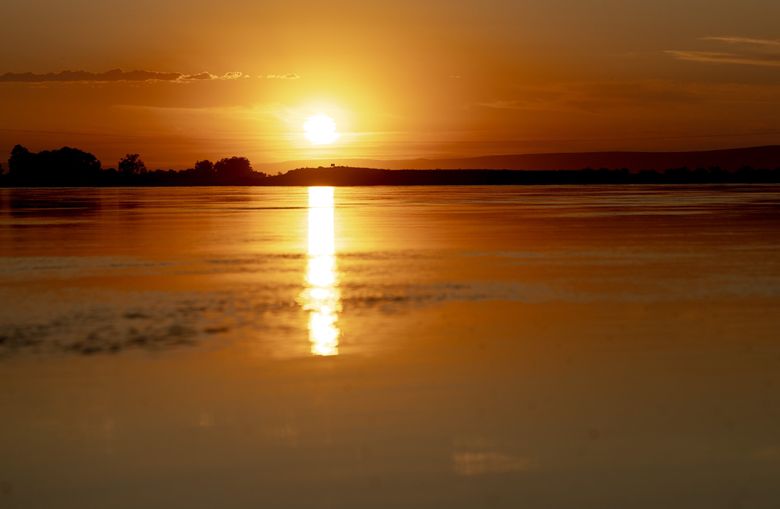
The sun sets over the Columbia River within the Hanford Reach National Monument on July 8. (Nick Wagner / The Seattle Times)
As for a national park designation, Murray laid out that potential path in a phone interview from the Capitol, a few weeks before she was scheduled to board the Can Do III. A new national park may be a longshot, but like every conservation effort along Hanford Reach, it will help to have a smooth operator manning the jetboat.
“I would want to make sure that I sat down with people from the region and there was a broad local consensus from everybody that’s what they want for the future,” Murray said, referencing “the tribes, the community leaders, the businesses, and certainly the passionate river advocates, the fishermen, the environmentalists. Because you cannot pass something back here without a broad coalition.”
WA national monument, made in 2000, is still protected by this family
READ MORE NEWS


